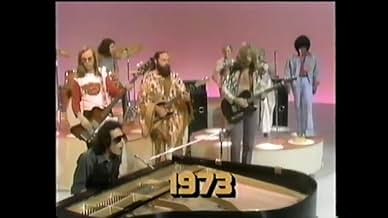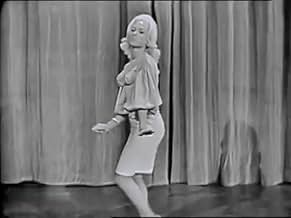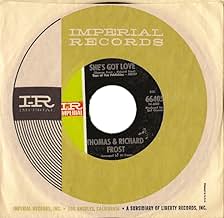Adicionar um enredo no seu idiomaDick Clark hosts a daily to weekly dance show that features the latest hit music for the attending teens to dance to. In addition, the show has performances by popular musicians and audience... Ler tudoDick Clark hosts a daily to weekly dance show that features the latest hit music for the attending teens to dance to. In addition, the show has performances by popular musicians and audience members rate songs.Dick Clark hosts a daily to weekly dance show that features the latest hit music for the attending teens to dance to. In addition, the show has performances by popular musicians and audience members rate songs.
- Prêmios
- 4 vitórias e 11 indicações no total
Explorar episódios
Avaliações em destaque
I remember watching this show every Saturday afternoon when I was a child and I always had a lot of fun doing it. It featured a lot of awesome musical talent in the many years that it was on and Dick Clark was always an excellent and cordial host. The dancers always looked so alive on the dance floor and you could just tell that they were loving every minute of it. My memories of this show are very easily among my favorite memories of sitting in front of the television set when I was a child. It's very easy to understand why it lasted so many years.
Although "Bandstand" apparently got its start in 1952, I first became familiar with it during the late 1950s and early 1960s, when Dick Clark was hosting the show. I became a teenager in 1958, and although I lived in a small southern town, I felt as much a part of Bandstand as those kids in Philadelphia. My mother and father both worked, so I was usually alone during the afternoon, after school. I remember my usual routine -- cook some frozen fish sticks in the oven, and settle down to watch Bandstand.
Part of the format involved playing several new songs, and having a small panel of teens rate then, to predict which ones had the best chance of becoming a hit. Of course, those of us who were watching often went over to the record store the next chance we had, to buy a copy of the winners, so the predictions became self-fulfilling. The biggest thrill was actually seeing on TV, the singers that we only knew through listening to the records. Brenda Lee. Leslie Gore. Paul and Paula. Bobby Vinton. Names that most of the younger generations would never recognize. And now, some of that is being brought to us in the Dick Clark sponsored TV series, "American Dreams." Bandstand, an important TV program in my formative teen years.
Part of the format involved playing several new songs, and having a small panel of teens rate then, to predict which ones had the best chance of becoming a hit. Of course, those of us who were watching often went over to the record store the next chance we had, to buy a copy of the winners, so the predictions became self-fulfilling. The biggest thrill was actually seeing on TV, the singers that we only knew through listening to the records. Brenda Lee. Leslie Gore. Paul and Paula. Bobby Vinton. Names that most of the younger generations would never recognize. And now, some of that is being brought to us in the Dick Clark sponsored TV series, "American Dreams." Bandstand, an important TV program in my formative teen years.
My family, friends and co-workers all remember Saturday's weekly TV series American Bandstand back in the 1960's and 1970's when it was THE ONLY music related theme show that could compete each week with the popularity of the following evenings Sunday night TV's Ed Sullivan show. Dick Clark as host was that perennial television star who seemed to have found the fountain of youth and just never seemed to age.
Each week the music that played and was danced to were the most popular songs of that day and when Dick Clark would ask some of the studio fans who were grooving and dancing to the music playing they would invariably respond with something like the following, "Well, I just like the beat. It's a beat we can dance to really easy. I just like the beat".
Yes for the most part the TV audience dancing to the songs playing represented a white mid-west America audience, but I believe it fair to say that American Bandstand would bring in the live talent from all across the country. The TV series sound stage was produced and filmed from the home of soul music in Philadelphia and yes from the great soul singer James Brown and Chubby Checkers, to crooners like Bobby Darin and Neil Sedaka, country singers like Johnny Cash and Dolly Parton, pop singers like the Carpenters and the Supremes, and rock and roll like Chuck Berry, the Animals and Creedence Clearwater Revival. American Bandstand never disappointed their television audience that tuned in each week to hear the beat, and maybe just a bit tongue in cheek laugh and criticize the shows dancers hokey dance moves, or their wide bell bottom pants and long hair or huge afros. Not only was American Bandstand the epicenter of the hip music, it was also a platform for teenage dress and fashion statements.
Who can not say that after more than 30 consecutive seasons on the air that if you were born prior to the 1980's that you didn't watch American Bandstand, didn't enjoy the music and the music guests that appeared each week? If you were not a fan of American Bandstand than you probably still tuned in and watched the TV show on Saturday as its critic so that you could make fun of the hokey dance moves that were displayed, the abstract fashion statements and hairdos (such as the women's beehive hairstyles and the men's two foot high afros).
Dick Clark's soothing voice and his ease with which he interacted with his musical guests made him the perfect host, and allowed us the audience to spend a Saturday for an hour or so enjoying great music guests, classic music and dance moves and ohhhh the fashion statements when we reminisce. Who can forget American Bandstand that lasted for 32 wonderful seasons. We miss you Dick Clark. God bless.
Each week the music that played and was danced to were the most popular songs of that day and when Dick Clark would ask some of the studio fans who were grooving and dancing to the music playing they would invariably respond with something like the following, "Well, I just like the beat. It's a beat we can dance to really easy. I just like the beat".
Yes for the most part the TV audience dancing to the songs playing represented a white mid-west America audience, but I believe it fair to say that American Bandstand would bring in the live talent from all across the country. The TV series sound stage was produced and filmed from the home of soul music in Philadelphia and yes from the great soul singer James Brown and Chubby Checkers, to crooners like Bobby Darin and Neil Sedaka, country singers like Johnny Cash and Dolly Parton, pop singers like the Carpenters and the Supremes, and rock and roll like Chuck Berry, the Animals and Creedence Clearwater Revival. American Bandstand never disappointed their television audience that tuned in each week to hear the beat, and maybe just a bit tongue in cheek laugh and criticize the shows dancers hokey dance moves, or their wide bell bottom pants and long hair or huge afros. Not only was American Bandstand the epicenter of the hip music, it was also a platform for teenage dress and fashion statements.
Who can not say that after more than 30 consecutive seasons on the air that if you were born prior to the 1980's that you didn't watch American Bandstand, didn't enjoy the music and the music guests that appeared each week? If you were not a fan of American Bandstand than you probably still tuned in and watched the TV show on Saturday as its critic so that you could make fun of the hokey dance moves that were displayed, the abstract fashion statements and hairdos (such as the women's beehive hairstyles and the men's two foot high afros).
Dick Clark's soothing voice and his ease with which he interacted with his musical guests made him the perfect host, and allowed us the audience to spend a Saturday for an hour or so enjoying great music guests, classic music and dance moves and ohhhh the fashion statements when we reminisce. Who can forget American Bandstand that lasted for 32 wonderful seasons. We miss you Dick Clark. God bless.
All the greatest songs ever recorded.
All the Number One Hits.
All the latest dances.
All the greatest musical guests of all time.
For three decades,Dick Clark brought you the best in entertainment.
From 1957 until 1989,this show was a Saturday afternoon staple for the teenage set.
That show was American BANDSTAND. It ran for 37 years on ABC-TV. For the three decades that it ran on the ABC network,it went on to become the third longest-running musical variety show of all time. During the last nine seasons of the show(1980-1989)the show saw a decline to some heavy competition,but due to the loyal support of the viewers,the show survived inspite to some newer viewers and a whole new generation.
It's easy to understand why it lasted three decades and was one of the top shows among the teenage set.It also paved the way for the next generation and the beginning of the "MTV" status that was to follow. Dick Clark was always the excellent and cordial host,who held his own,and remain so until the final episode of the series in 1989. Thank you,Dick Clark for making this possible.
All the Number One Hits.
All the latest dances.
All the greatest musical guests of all time.
For three decades,Dick Clark brought you the best in entertainment.
From 1957 until 1989,this show was a Saturday afternoon staple for the teenage set.
That show was American BANDSTAND. It ran for 37 years on ABC-TV. For the three decades that it ran on the ABC network,it went on to become the third longest-running musical variety show of all time. During the last nine seasons of the show(1980-1989)the show saw a decline to some heavy competition,but due to the loyal support of the viewers,the show survived inspite to some newer viewers and a whole new generation.
It's easy to understand why it lasted three decades and was one of the top shows among the teenage set.It also paved the way for the next generation and the beginning of the "MTV" status that was to follow. Dick Clark was always the excellent and cordial host,who held his own,and remain so until the final episode of the series in 1989. Thank you,Dick Clark for making this possible.
Pepsi Cola had a very catchy slogan during the 1980s. But unlike "Pepsi" American Bandstand was NOT the choice of a New Generation! The long running music show had a big part in mainstreaming Rock N' Roll. Long time host Dick Clark had a winner for decades. Adolescents was the backbone of it's audience, butGeneration X was slow to embrace AB because MTV conspired with: syndicated, network and local music video programs to challenge American Bandstand's legacy. Music Videos had very little if any audience interaction, unlike Bandstand. This is regardless of whether the interaction had to do with a studio or television audience. VeeJays merely played videotapes. But on the contrary most television viewers did not have to wait for Noon Eastern on Saturday to see their favorite artists perform. Music Videos from decades prior to the Eighties consisted of footage from American Bandstand and talk or variety shows. But now the producers and directors of videos were no longer limited to the set of American Bandstand. They can shoot their videos on location or on major studio backlots. They had the freedom to use : animation, special effects, or any other format they liked. But during this added dimension in pop music what was the viewing experience like for American Bandstand? You tuned in to watch other people dance and to watch recording artists give lip-synch performances. "Dude! That is like, so lame!" As the youngsters would say in 1980s vernacular. With the advent of the Music Video Shows American Bandstand just seemed kind of weak! You may say "Skillz! if it was so lame then explain why a program like the syndicated 'Soul Train' continued to flourish with a simular blueprint of dancing and lip-synching?" I will tell you why! Because viewers wanted to dress in the festive gear that they saw on Soul Train, and they wanted to emulate the dance moves that they saw on the show that was dubbed "The Hippest Trip in America". You watched Soul Train so that you can look and dress the part; and you went clubbing with hopes that you would not leave the disco by yourself! But even compared to its more Nubiancentric competitor American Bandstand paled by comparison. Most of what you saw on Bandstand in the 1980s consisted of dancers dressed like they were at a church picnic and moved like wind-up dolls on the AB dance floor. AB was clearly a shadow of its former self. During the decade of New Wave and Boat Shoes and Micheal Jackson kids just didn't aspire to appear on American Bandstand like they did during previous decades. AB simply experienced the ratings dooldrums at best. Finally ABC ended it's long association with the music show and American Bandstand crawled to basic cable to die.
Você sabia?
- CuriosidadesWith 37 continuous years on the air, this was the longest-running weekly popular music showcase TV program in the world. The BBC's Top of the Pops (1964) broke that record in 2001, when it entered its 38th year on air.
- Versões alternativasAlso available in a computer colorized version.
- ConexõesFeatured in The Movie Orgy (1968)
- Trilhas sonorasBandstand Boogie (The Theme of 'American Bandstand')
Written and Performed by Charles Albertine, Les Elgart & Bob Horn from 1952 to 1977
Principais escolhas
Faça login para avaliar e ver a lista de recomendações personalizadas
- How many seasons does American Bandstand have?Fornecido pela Alexa
Detalhes
- Tempo de duração
- 1 h 30 min(90 min)
- Proporção
- 1.33 : 1
Contribua para esta página
Sugerir uma alteração ou adicionar conteúdo ausente















